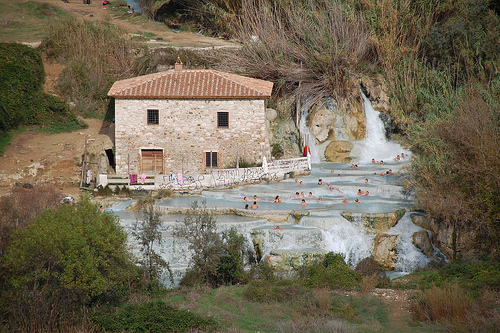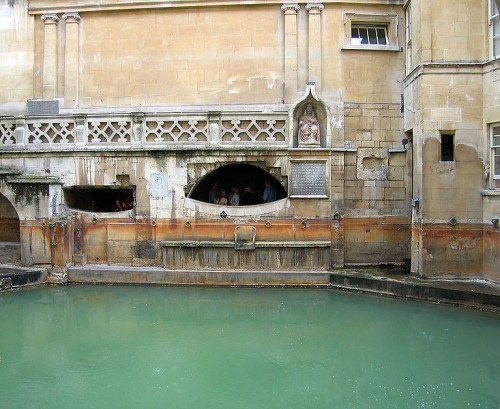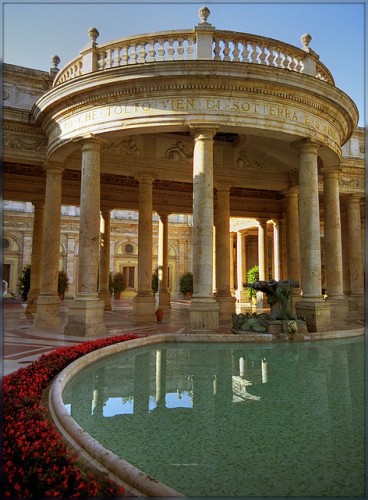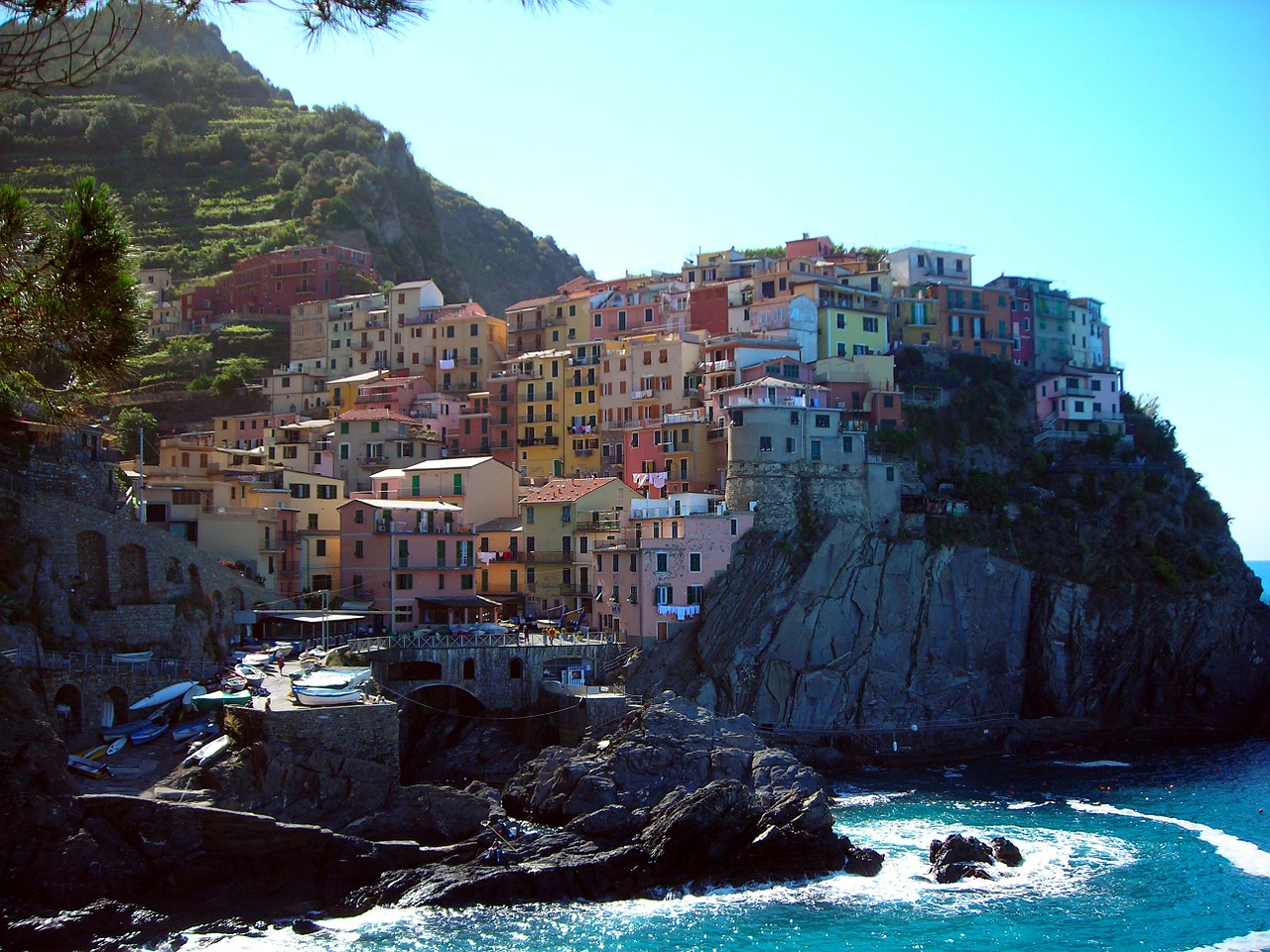Many who are interested in travel are aware of the allures of visiting Italy; delicious food, beautiful art, interesting history. But what quite a few people may not know is that Italy also has great water. I’m not talking about bottled or tap; I’m talking Italy’s wealth of natural spas.
A little spa background…
Since before the Roman era, people have enjoyed the benefits of natural thermal and mineral spas. Their therapeutic properties make them ideal for revitalizing both the mind and body. These spas aren’t your run of the mill, mani-pedi-facial stations; instead, they offer a relaxing and healing retreat that utilizes the Earth’s natural resources in centuries old traditions.
Despite sharing a common name, each spa is a unique wonder of the natural world. Different and distinct properties make each different spa an optimal remedy for an array of ailments.
One characteristic that can affect how the spa will affect you is temperature; the water temperature can range anywhere from hotter-than-your-average-hot-tub to absolutely bone chilling. Meanwhile their chemical composition, which depends on the presence of dissolved solids in the water, is also very important. Other important components in determining a spa’s benefits include the presence of gases and the nature of mud in the surrounding area.
All of these factors combine to create a variety of spas, all with their own specific assets. Because of the presence of volcanic phenomena and the abundance of underground water channels, Italy is a great destination for those looking to sample some spas.
Some Notable Spas:
In Northeastern Italy many spas have developed in the Veneto region, on the slopes of the Euganei Hills (Colli Euganei). Because of volcanic activity beneath the ground, numerous hot springs gush out of the area, making it an ideal place for some steamy soaking. In addition, Veneto is known for treatments of mud therapy, which are recommended for skin health, rheumatic illnesses and problems of the respiratory organs.
While here you may want to specifically check out Abano Terme. Originally called Abano Bagni, this area is thought by many to be the oldest spa region in the world. And, it’s home to a whopping 130 thermal springs! Though the town surrounding it doesn’t offer much in the way of sight-seeing, I doubt you’ll be disappointed while you’re basking in the 90 degree water that surges up from 2000 meters underground.
In addition you can enjoy the renowned mud treatments, which employ the volcanic mud and ash from the surrounding area. An excursion to this spa can be beneficial for the skin, osteoporosis, arthritis, rheumatism, joint pain, muscle pain, gout, respiratory diseases, and recovery from fractures and surgery. Or it can simply be relaxing.
In the region of Emilia-Romagna, in the foothills of the Apennines, you’ll find spas that are predominantly sulphurous, or which contain sodium chloride, iodide, or bromide. The spas in this area are therefore recommended for metabolism disorders, skin diseases, and problems of the respiratory and vascular system. One of the most sulphurous spas in this area is called Tabiano Terme, and today it is most commonly visited for problems of the lungs, ears, nose and throat.
Another spa, Salsomaggiore Terme, has become popular due to its extremely high sodium content; the water is practically considered salt-water. People come to Salsomaggiore from far and wide to rid themselves of bronchial and gastric problems and to witness the finals of “Miss Italia,” which are held there once a year. And, if you need any extra enticing to visit Salsomaggiore, it’s rumored that the gelateria in the center of town is worth the trip all by itself.
Tuscany also boasts it’s shares of spas. If it’s reputation for gorgeous landscapes didn’t already have you packing your bags and hopping on a plane to visit, then maybe its spas might provide a little extra push.
The largest and most famous of Tuscany’s spa regions is Montecatini. Home to nine spas and over 600 years of tradition, it draws in approximately 1,700,000 visitors every year. In case that number doesn’t speak for itself, don’t forget the marble columns, spacious halls, and gorgeous gardens that make each spa in Montecatini a virtual palace of relaxation. To top it all off, the waters contain several minerals that are thought to treat liver and digestive disorders.
Another frequently visited Tuscan retreat is Chianciano, which sees even more visitors than Montecatini (1,860,000 visitors a year). Famous for the treatment of liver ailments, the spas in this area offer a variety of treatments including thermal baths, inhalation therapies and mud therapies. In addition, some of the spas here have water that is safe to drink and which can be beneficial in remedying gastrointestinal disorders.
Don’t let the spotlight on Chianciano and Montecatini make you miss out on Terme di Saturnia. What this spa region lacks in size it makes up for in serenity and variety. Saturnia offers not only the traditional water therapies but also beauty treatments, diet plans, fitness regimens, and stress therapies.
Ischia, in Campania, gets about 2,400,000 visitors a year. Volcanic activity makes this spa region home to both natural hot springs and geysers. But this is no Yellowstone Park. Ischia offers all the inhalation treatments, baths, steam baths and mud therapies you can find at many of the Italian thermal spas and it offers more. Popular with many visitors is their naturally heated caves which can function like a dry sauna or like a humid Turkish bath.
Lazio, the region in which the capital city of Rome was founded, is also a region in which spas can be found. Famous for its treatment of renal calculus, kidney stones, Fiuggi is a famous spa region you will not want to miss. It is a short distance south of Rome and it has treated not only European royalty, but also Michelangelo and a few Popes as well.
Though perhaps not as popular with the Pope, Bagni di Tivoli is certainly popular with other spa goers. These hot sulphurous springs were praised by the classical Roman poet, Virgil, in ancient times. Nowadays the waters here are ingested to treat gastrointestinal disordered and inhaled to promote nose and throat health. In addition, the sulphur waters and mud are used in soothing baths for arthritis and skin disorders.
How to decide?
There are so many types of spas to consider. Keep in mind your goals in visiting the spas:
Are you looking to remedy a specific disorder? Or are you simply looking for somewhere to relax? Each spa has different properties which influence their effectiveness in dealing with certain stress-related or physical complaints. That said, it is always wise to consult with some sort of healthcare professional before taking part in any spa experience.
By asking yourself these types of questions you’re sure to find a spa that’s tailor made for you!
Written by: Kelly Whelan Photo Credits : Darren Donahue / Solipsist / Nigelfj




